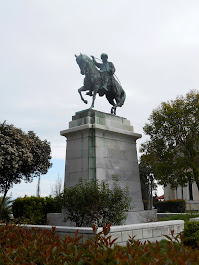Continuing eastwards from Kavala, I reached Xanthi, in western Thrace. Xanthi has a well preserved, beautiful old town. Many of its old buildings have been sensitively renovated. Ottoman-style houses, with their first floors built out over the narrow streets, as if reaching out to touch each other, are interspersed with grand mansions more in a European style, built by rich 19th century merchants. Streets lead into little tree-shaded squares with stylish cafés. Xanthi has a bohemian atmosphere. Sculptures, fashioned out of metal, are dotted around the old town.
The region of Xanthi was known for the quality of its tobacco, and the city’s mansions were built by the mainly Greek merchants who prospered from it. Especially impressive is the house of Vasilios Kougioumtzoglou, built in 1877, with its colourful, decorated exterior. The Kougioumtzoglou family also owned another large house on the same street, which today houses Xanthi’s folklore museum. Inside, the visitor can walk through rooms depicting the life of a period Greek home of the 19th century. The family also owned a house in Plovdiv (Philippopolis in Greek), in present-day Bulgaria, indicating the one-time interconnectedness of the region.
Xanthi was part of the Ottoman Empire until 1912, when it was taken by Bulgaria during the first Balkan War. Together with the rest of western Thrace, it became part of Greece after the First World War, and, apart from a period back under Bulgarian rule during World War II, it has remained with Greece since then. More than anywhere else I have been, in Xanthi I could see vestiges of the prosperity and accomplishment of the Ottoman Greeks. The once great cosmopolitan cities of the eastern Mediterranean, Smyrna, Salonika, Alexandria, have been devastated by the tragic events of the 20th century, destructive fires and war, which have left only traces of their past glory. But, on a smaller scale, Xanthi has been preserved, and some flavour of that past era can be sensed today, walking among the mansions of this once flourishing town.
The Ottoman Greeks enjoyed levels of prosperity and development far beyond those of the independent Greek state in the 19th century. Greek Levantine merchants and financiers spread their wealth and power around Europe. Their educational establishments and cultural achievements were widely admired. In the fine little town of Xanthi this has left an echo which has largely been lost in most of the rest of the region.
Xanthi also offers a reminder of the cosmopolitanism of so many eastern-Mediterranean towns before the break-up of the Ottoman Empire and the onset of the narrow nation state. When Greece and the newly established Turkish republic agreed, by the Treaty of Lausanne, on the population exchange which in 1923 ended centuries of co-existence between Greeks and Turks, two exceptions were made. Muslims (Bulgarian speaking Pomak and Romany Muslims as well as Turks) would be allowed to remain in Greek western Thrace, and Greeks could remain in Istanbul. Most of the Istanbul Greeks were driven out in the 1950s, leaving only a tiny remnant today. But the Turks of western Thrace are still there.
Life has not always been easy for them. At the beginning of the 20th century, Muslims formed a significant majority in Xanthi, but, following the settlement of Greek migrants from Turkish eastern Thrace and Anatolia, and outward migration by local Turks, they are now very much a minority. Events outside Greece have sometimes had negative repercussions for them. Following the 1955 pogroms against Istanbul Greeks, Greece retaliated by introducing a law depriving Muslims who left Greece of their citizenship. And in response to the declaration of independence by Turkish north Cyprus in 1983, the Greek government adopted a policy of referring to ‘Greek Muslims’, no longer recognising a Turkish minority. Greek courts outlawed the term ‘Turkish’ in reference to the community in western Thrace.
Such treatment no doubt made Turks in western Thrace feel less than welcome, and there were protests. But they clung on. And now, as far as can be seen, they rub along with their Greek neighbours, much as they have for centuries. Walking around Xanthi, women in headscarves go about their business. At one end of the old town, climbing up the hill, the old Muslim quarter remains just that. At the top of the hill, the Achrian Mosque, built after 1850, has notices outside in Greek, English and Turkish. People greet each with ‘as-salaam alaikum’, and chat away in Turkish. Children kicking a ball around shout to one another in Turkish.
I liked Xanthi, a town that has preserved its heritage, architectural and communal. Here, unlike almost anywhere else in either Greece or Turkey, the history of co-existence between Greeks and Turks has been preserved, and it seems to work.






